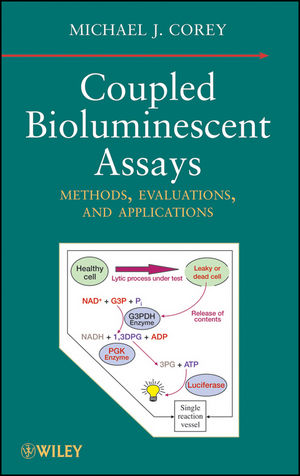Coupled Bioluminescent Assays: Methods, Evaluations, and ApplicationsISBN: 978-0-470-10883-3
Hardcover
320 pages
December 2008
 This is a Print-on-Demand title. It will be printed specifically to fill your order. Please allow an additional 10-15 days delivery time. The book is not returnable.
|
||||||
PART I BACKGROUND TO COUPLED BIOLUMINESCENT ASSAYS.
1 Introduction.
1.1 Introduction to Coupled Bioluminescent Assays.
1.2 Luminescent Technologies of the Life Sciences.
1.3 Varieties of Fluorometric Assays.
1.4 Chemiluminescence and Bioluminescence.
1.5 Common Bioluminescence Systems.
1.6 A Coupled Bioluminescent Reaction.
1.7 Summary.
2 Coupled Bioluminescent Reactions in Practice.
2.1 Principles of Coupled Bioluminescent Reactions.
2.2 Instrumentation and Equipment for Coupled Bioluminescent Assays.
2.3 Coupled Bioluminescent Assay Procedures and Precautions.
2.4 Data Handling for Coupled Bioluminescent Assays.
2.5 Comparison of Coupled Bioluminescent Assays with Other Methods.
PART II BIOMEDICAL APPLICATIONS OF COUPLED BIOLUMINESCENCE.
3 Coupled Bioluminescent Cytotoxicity Assays.
3.1 Introduction.
3.2 Membrane Integrity Assays.
3.3 A Coupled Bioluminescent Assay for Enzyme Release: The G3PDH-Release Assay.
3.4 Viability Assays.
4 The Role of Coupled Bioluminescent Assays in Kinase Screening and Study.
4.1 The Many Roles of Kinases in Biology.
4.2 Current Standard Kinase Assays.
4.3 Coupled Bioluminescent Kinase Assays.
4.4 Conclusions.
5 Coupled Bioluminescent Phosphatase Assays.
5.1 Introduction.
5.2 Phosphatases.
5.3 Contemporary Phosphatase Assay Technologies.
5.4 CB Phosphatase Assays.
5.5 Conclusions.
6 Acetylcholinesterase.
6.1 Introduction.
6.2 Established AChE Assay Methods.
6.3 Recent Developments in AChE Assay Methods.
6.4 Evaluation of Current AChE High-Throughput Screening
Methods.
6.5 Coupled Bioluminescent Assays of AChE Activity.
6.6 Comparison of Coupled Bioluminescent and Other Methods of Measuring AChE Activity.
7 Measurement of Nitric Oxide Synthase Activity by Coupled Bioluminescence.
7.1 Introduction.
7.2 Current NOS Assays.
7.3 Conclusions.
8 The Coupled Bioluminescent Pyrophosphorolysis Assay.
8.1 Introduction.
8.2 Genetic Variation in Modern Medicine.
8.3 DNA Complementarity.
8.4 The READIT® Pyrophosphorolysis Assay.
9 Coupled Luminescent Assays of G-Protein-Coupled
Receptors.
9.1 Introduction to G-Protein-Coupled Receptors.
9.2 GPCR Assay Methods.
9.3 Summary.
10 Coupled Bioluminescent Protease Assays.
10.1 Introduction.
10.2 Protease Assays.
10.3 Coupled Bioluminescent Protease Assays.
10.4 Summary.
11 Coupled Luminescent Assays Involving Aequorin.
11.1 Introduction to Aequorin.
11.2 Detection of Calcium in Practice.
12 Coupled Bioluminescent Reporter Assays.
12.1 Introduction to Reporter Assays.
12.2 Luciferases as Reporters of Promoter Activities.
12.3 Aequorin as a Reporter Enzyme.
12.4 Vectors for Use in Reporter Assays.
12.5 Summary.
13 Coupled Bioluminescent Assays: Regulatory Concerns.
13.1 Introduction.
13.2 Regulatory Aspects of Assay Development.
13.3 Summary.
PART III OTHER APPLICATIONS OF COUPLED BIOLUMINESCENCE.
14 Coupled Bioluminescent Determination of Bioburden and Sterility.
14.1 Introduction.
14.2 Rapid Methods of Bioburden and Sterility Assessment.
15 Environmental Applications of Coupled Bioluminescent Assays.
15.1 Introduction.
15.2 Current Methods for Environmental Monitoring of Water Quality.
15.3 Methods of Monitoring Stream Water and Lake Water.
15.4 Methods of Monitoring Drinking Water.
Appendix A: One-Letter Amino Acid Abbreviations.
Glossary.
Bibliography.
Index.



